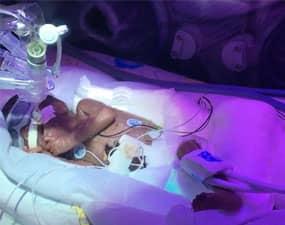Kareem and Katonya’s Story

We would like to share Kareem’s story as part of our support for Prematurity Awareness Month.
Katonya was at home, alone, and twenty-two weeks pregnant. Katonya had woken up with cramps, and joked to her partner that she was having contractions already. Her doctor’s appointments had all been routine, so she was not unduly worried, and her partner left for work as normal.
Katonya lay down on the couch to try and get comfortable when her water broke, and the cramps which she soon realized were contractions, became more frequent. With her cellphone on her chest Katonya was giving directions to emergency services when she started to see the head of her baby. She describes her shock once she realized that her baby had arrived, months early, and not in a hospital.
“It was an out-of-body experience,” Katonya said, “I could not believe what my eyes were seeing. I had to glance down five to ten times before I could take in what was happening, and tell the operator that my baby was here. The 911 responder instructed me to pull my baby out, and to wipe his eyes and airways. I did as I was told, but I was so afraid to move in case I hurt him.”
Mom and baby were taken to the local hospital and baby Kareem was transferred to Stony Brook Children’s Hospital NICU weighing just 1lb 6oz.
The first person Katonya talked to at Stony Brook was a nurse named Donna Panico, “who I love and adore”, says Katonya. “She was the first nurse I dealt with. Her demeanor makes her the perfect person when your child is in critical condition. She knew everything about my child but she was so gentle with us, the parents.”

Then came 180 days in the NICU. Every day was a new challenge. Kareem was not born in a sterile environment and his skin was fragile and translucent. He was on a ventilator for months with chronic lung issues. He had a hole in his heart. Kareem had so many blood and platelet transfusions that his family had lost count. Through the long months Katonya and her family worked with Stony Brook Children’s staff and the March of Dimes NICU Family Support Program.
Through the long months Katonya and her family worked with Stony Brook Children’s staff and the March of Dimes NICU Family Support Program.
Katonya visited little Kareem every day and bought a recorder into the NICU so that he could always hear her voice—singing him songs and reading him stories. After six months in the NICU, and initially lots of nursing and medical support at home for mom, Kareem was finally ready to come home.
Now Kareem is a healthy young boy and he is running around, jumping on the trampoline, and playing with cars. But music is now the key to his heart. After months listening to his mom on the recorder, Kareem mostly just loves to dance and sing.
Katonya has some great advice for both expectant and preemie moms
Learn the symptoms
Katonya had no idea that the “cramping” feeling she experienced could be contractions, because in her mind it was just too early. Many women who deliver prematurely have no idea what is happening with their bodies, they think that they are suffering with cramps, Braxton Hicks contractions or acid reflux.
Not all prenatal appointments include discussions about the symptoms of pre-term labor, so ask your doctor what to look out for.
Call your doctor if you are experiencing any of these symptoms (from March of Dimes):
- Change in your vaginal discharge (watery, mucus or bloody)
- Pressure in your pelvis or lower belly, like your baby is pushing down
- Constant low, dull backache
- Belly cramps with or without diarrhea
- Regular or frequent contractions that make your belly tighten like a fist. The contractions may or may not be painful.
- Your water breaks
Educate yourself but don’t get ahead of yourself.
When a baby is born very early things can change every day.
Katonya suggests that if you have a very premature baby, try to educate yourself about your preemie baby’s current set of medical conditions, without worrying too much about what’s ahead.
The medical team is your coach, your village, your therapists. They are the ones who are knowledgeable about what is going on with your baby. Katonya says, “Any questions, ask. No question is a dumb question.”
Connect with others families in the NICU
Connecting with other families in the NICU helps give you strength, courage and hope. It was amazing to have a staff member such as Danielle Donohue, the March of Dimes Coordinator, to be a part of our journey. Not only did she understand from a medical stand point, she herself is a mom of two beautiful premature children. She understood the emotions of what a parent is experiencing in the environment she services.
Keep a Journal
When there are so many changes every day, it is helpful to keep a journal. It helps moms and dads to keep an update of their baby’s progress, including metrics like weight and height information, medication, and blood transfusions. Katonya has learned so much from everything that happened to her family that she hopes to share her experience in a future memoir.
Learn Boundaries
Katonya learned that for a child so tiny and vulnerable, any visits from family in the early stages of a cold or flu could be fatal. Knowing that Kareem was fighting for his life and a common cold could be disastrous, Katonya and her partner decided to limit family and friend visits.